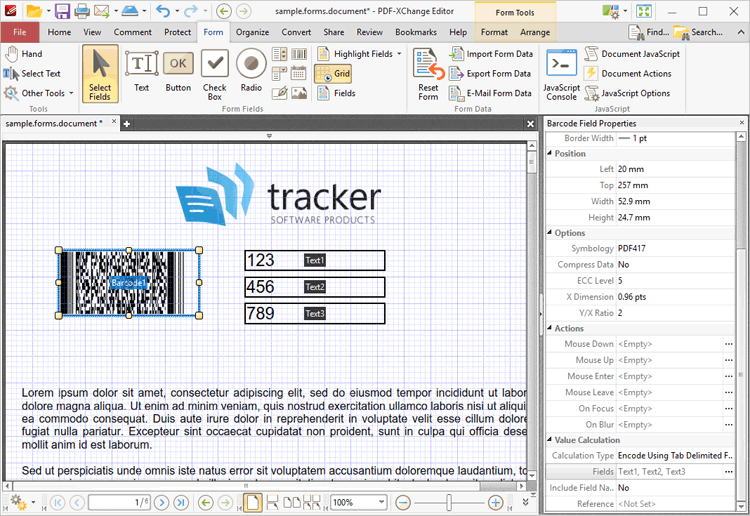 Add Barcodes to Documents
Add Barcodes to Documents
Barcodes enable the encoding of form data and display it as a visual pattern that can be decoded by compatible software/hardware:

Figure 1. Example Barcodes. PDF417 Barcode (Left), QR Code Barcode (Center), Data Matrix Barcode (Right)
The functionality of PDF-XChange Editor enables a wide range of dynamic customization for barcodes. Click the dropdowns below for further information:
1. Click the Form tab, then click Barcode (highlighted in the image below). A blue rectangle will be displayed at the location of the pointer. This rectangle represents the barcode:
Figure 2. Active Barcode Tool
2. Move the rectangle to the desired location and then click to add the barcode to the document. Added barcodes appear as below:
Figure 3. Added Barcodes
•Click and drag the yellow control points to resize barcodes. •Use the options in the Format Tab to determine the style and appearance of selected barcodes:
Figure 4. Format Tab, Barcodes
•Click Select Fields to select and edit form fields. •Click the options in the Form Fields group to enable alternative form field formats. •Click Keep Mode to create multiple barcodes consecutively. If this option is disabled then PDF-XChange Editor will revert to the designated default tool after the creation of a single barcode. •Click Tab Numbers to show/hide the tab order numbers of form fields. •The Calculation Order setting is not available for barcodes. •Click Grid to enable/disable the grid, which is used to assist in the accurate placement of form fields, as detailed in (figure 4). •Click Create Multiple Copies to create multiple copies of selected form fields, as detailed here. •Click Fields to show/hide the Fields pane, which is used to view/edit form fields. •The Fill Color option is not available for barcodes. •Click Stroke Color to determine the border color of barcodes. •The Width, Border and Font options are not available for barcodes. •Click Properties to open the Barcode Field Properties pane, which enables the customization of additional elements of barcodes and is detailed below.
|
The following example will detail the creation of a barcode that represents numerical form data entered elsewhere in the same form:
1. Click the Form tab, then click Barcode. The blue rectangle that represents the barcode will be displayed:
Figure 9. Active Barcode Tool
2. Click to add the barcode, then click the Format tab and click Properties. The Barcode Field Properties pane will open:
Figure 10. Active Barcode Tool, Barcode Field Properties Pane
3. Scroll down the Barcode Field Properties pane to the Calculation Type property, then select Encode Using Tab Delimited Format:
Figure 11. Calculation Type Property, Encode Using Tab Delimited Format
The next step is to create the form fields from which the barcode will take its data:
4. Click Text Field and Keep Mode, then click to add some text fields to the document:
Figure 12. New Text Boxes
5. Click the Home tab, then click the Hand Tool. Select the text fields one at a time and enter some numerical data:
Figure 13. Active Hand Tool
6. Click the Form tab, then click Select Fields and select the barcode:
Figure 14. Selected Barcode
7. Scroll down the Barcode Field Properties pane to the Fields property (highlighted in the image below) and click the ellipsis icon. The Field Selection dialog box will open. Note that the text fields entered at step four each feature a corresponding check box. Select the boxes of the forms to be included in the creation of the barcode and click OK:
Figure 15. Selected Barcode and Field Selection Dialog Box
The barcode will update to represent the numerical information:
Figure 16. Updated Barcode
If the content of the text fields used to create the barcode is updated then the barcode will update to represent the new information. |














